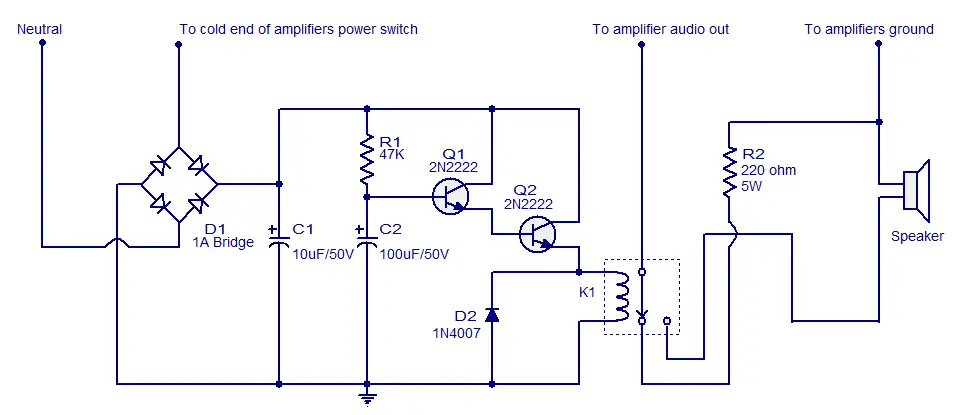Description.
When the amplifier is switched on, the speaker gets popped up by a high voltage and you can hear a loud thud sound from the speaker. This stuff is very harmful to the speaker and it drastically reduces the speaker’s life. The circuit shown here connects the speaker to the power amplifier output only after a few seconds the amplifier is powered ON.
A simple transistor based time delay circuit is used for attaining the purpose. The circuit is so connected to the existing amplifier that, when the amplifier is powered on the bridge D1 also gets powered through the amplifier’s power switch. Capacitor C1 filters the output of bridge rectifier D1.When the power switch is made ON, the Darlington pair (Q1 and Q2) gets switched ON only after the capacitor C2 is sufficiently charged (to 0.7V) through the resistor R1. Here the value of C2 and R1 are so selected that the time delay is around 2 seconds. So the relay gets activated only after a few seconds the amplifier is powered ON and until that time the speaker will be kept isolated from the amplifier’s audio output as the speaker is connected to the amplifier’s output through the N/O contact of the relay. During this initial delay period the output of amplifier will be grounded by the resistor R2 through the N/C contact of the relay. This is done in order to ensure that the DC blocking capacitor at the amplifier’s output is charged before it is connected to the speaker.
Circuit diagram.
Notes.
- The circuit can be assembled on a Vero board.
- Relay K1 must be an SPDT relay
- Voltage rating of the SPDT relay must be selected according to the supply voltage of your amplifier. For a 12V amplifier you need a 12V relay and so on.
- This circuit can be used for isolating only one speaker.
- For isolating two speakers you have to use a DPDT relay in place of K1.


6 Comments
In an international forum only in english please. so that all can participate
wow..keren…ku kopi boleh kan…
Hi The neutral return is through the bridge rectifier. When the amplifier is switched on the amplifier current flows through bridge rectifier since there is no load connected (Q1 and Q2 are off), the terminal voltage across bridge rectifier will almost reach 230/120V AC, which may damage C1, Q1 and Q2 instantly. This simple circuit can be hooked through a step down transformer with 12volt secondary and the primary connected to switched output socket of the amplifier.(This socket is provided in most of the amplifiers for swiching on other connected equipments)
When I first looked at this circuit it looked like it was hooked right to the line voltage. Many amps have their power switch on the incoming line 120Vac. This circuit uses the terminology of “neutral” which is typical of line voltage circuits.
I know this is not the intent because the caps used are only rated at 50v.
I think some clarification is in order here for safety sake.
Other than the above mentioned issue, I think this circuit is a good idea.
Regards
Stephen Payne